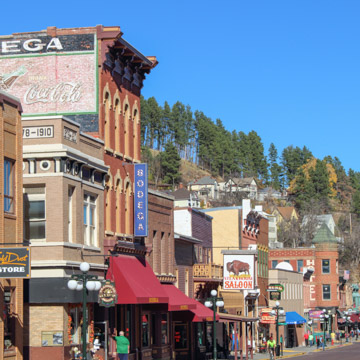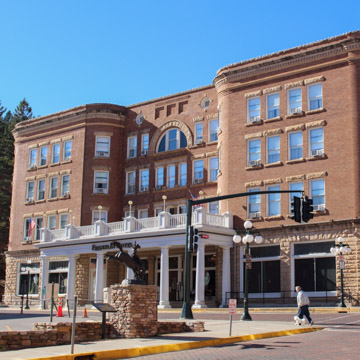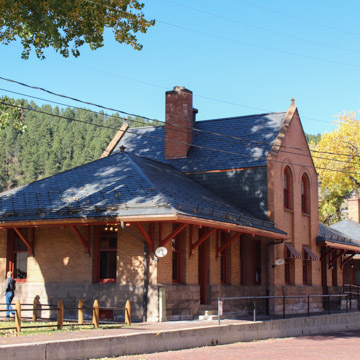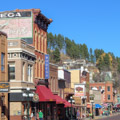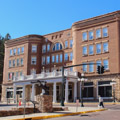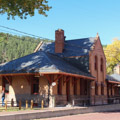Deadwood was founded in 1876 after gold was discovered in the northern Black Hills of South Dakota, and the town quickly grew to a population of approximately 5,000. It was laid out below the confluence of the Whitewood and Deadwood creeks, with mining claims divided into 300-foot parcels. The Y-shaped town was limited by the surrounding steep hillsides. Most settlers occupied tents, but with the opening of three sawmills in 1876 these were quickly replaced with log cabins and false-front wood-frame buildings in the town center, although tents continued to dot the hillsides. Deadwood became the supply center for all surrounding mines, not only providing mining supplies but also financing and entertainment. The prosperous town became known for its colorful history full of legendary figures such as Wild Bill Hickok, Calamity Jane, Seth Bullock, and Al Swearengen. Near the end of 1876, 200 buildings were completed, with the two- and three-story buildings along Main Street (west of Deadwood Creek) housing many of the town’s 173 businesses, which included a number of saloons and brothels. Crudely built two- and three-room log cabins were rented for $25 to $40 per month.
The town’s population comprised various ethnic groups, including European, Black, and Jewish settlers as well as a sizeable Chinese populace, many of whom had worked on the transcontinental railroad. Chinese settlers established themselves as miners, laundrymen, cooks, and servants, and established their community on the northeast end of Main Street—a strategic location since those entering Deadwood from that direction had to pass through Chinatown first. Like the rest of the town, vice thrived in Chinatown as well, with competing societies and citizens fighting for control of the general population as well as of opium sales and prostitution.
In September 1879, a fire destroyed many of Deadwood’s wood-framed buildings—around 300 of them. Rebuilding began immediately and, wherever possible, buildings were constructed of brick and stone, establishing the Victorian aesthetic that remains today. The vernacular architecture exhibits a mix of decorative elements from the Colonial Revival, Classical Revival, Second Empire, Queen Anne, Eastlake, and Italianate styles. Much of the downtown commercial center dates to this period of rebuilding, which stretched into the early twentieth century. The arrival of the railroad in 1890 helped transform the frontier town into a prosperous commercial center. While the commercial core remained along Main Street, residences were terraced up the surrounding hillsides, with the more respectable neighborhoods perched higher above the town. Many of the town’s public buildings were erected in the early twentieth century, including a Carnegie library (1904) and courthouse (1905).
The early twentieth century also brought about reform movements, with gambling and prostitution establishments coming under attack. Despite Prohibition and the fact that gambling was made illegal, during the 1920s these establishments continued to operate covertly. By that time, the mines had begun a steady decline and were mostly closed by the 1940s. Tourism then became the town’s driving economic force, first with the promotion of Black Hills tours by railroad companies, and then with the rise of the automobile. Another major fire in 1959 came close to destroying the town again and initiated a long period of economic downturn for the community.
Although mining operations had moved to nearby Lead and the Homestake Mine years before, a number of miners lived in Deadwood, which continued to provide entertainment in the form of backroom gambling and brothels. Gambling was officially shut down in 1947, and the last of the brothels was closed after a raid in 1980. In 1961, the entire town was designated a National Historic Landmark in recognition of the important role mining communities played in the development of the American West. But in December 1987, another major fire in the downtown commercial core resulted in significant changes to the town. Like the 1879 fire, which resulted in a more substantial downtown core, the 1987 fire was the catalyst for Deadwood’s revitalization.
In 1989, Deadwood legalized limited gaming with an eye toward generating funds to help preserve the historic town. Within a year, the community benefitted from significant revenues from the gaming industry. Growth and change since then has been regulated by the Deadwood Historic Preservation Commission, as well as the Planning Commission and the City Council. Care has been taken to protect individual historic properties and the community as a whole, through standardized design guidelines and adherence to the Secretary of the Interior’s Standards for Historic Rehabilitation. The move to legalize gaming has boosted the local economy, resulting in year-round visitors as opposed to the summer tourism of decades past. Restoration of historic buildings is ongoing, and new construction, especially on Main Street, must meet certain design criteria. In the early 2000s, however, development of casinos, hotels, and parking structures along the eastern edge of town on U.S. 85 threatened Deadwood’s historical integrity. Tourism remains the driving economic force in the town, and the gaming tax has enabled improvements to Deadwood’s water and sewer systems. Tourists are drawn to Deadwood, however, not only for legalized gambling but its unique and colorful history, popularly depicted in the eponymous HBO television series (2004-2006) and movie (2019).

